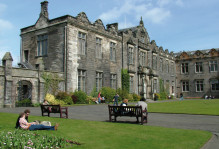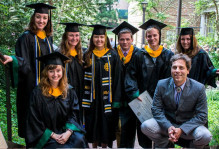Knowledge is good?
Back when I was a college student in the late 1970s, Animal House was one of the most popular movies in the country. You’ve probably seen it. The movie chronicles the hilarious hijinks of a group of student miscreants at the fictional Faber College. In an early scene, the camera pans the lush grounds at Faber, finally settling on a stone plaque that contains Faber’s motto: “Knowledge is Good.” At this point, audiences typically explode in laughter because the motto beautifully captures the pretension and vacuousness that people often associate with academic rhetoric.
Last September, W&M formally commenced a strategic planning process aimed at clarifying our priorities and goals as a university and linking them to concrete initiatives, budget allocations, and fundraising. Basically, we’re doing the vision thing. A 30-member Strategic Planning Committee (the PSC) that includes administrators, alumni, faculty, and students spent much of the fall conducting “campus conversations” with a remarkable array of people who care deeply about W&M. The goal was to get feedback about the most important challenges and opportunities that the College will face over the next few years and plan accordingly.
In November, the PSC used all of that feedback to devise a preliminary list of the fourteen most important challenges facing W&M in the next five to ten years, and then after meeting with the Board of Visitors winnowed the list to a half dozen or so “grand challenges,” and reported the results to President Reveley. He has tasked our deans, program directors, and various other administrators to work with their faculties to develop concrete goals and initiatives for dealing with these challenges.
For those of us interested in politics and reform, there may be an instructive case study in this entire effort.
The best scholarship indicates that, whether we’re talking about businesses, legislatures, or even universities, there can be a tradeoff between “top down” and “bottom up” approaches to organizational planning and change. Obviously, there are some real benefits when the leadership of an organization considers the views and insights of all members of the organizational hierarchy and all relevant constituencies when identifying challenges and priorities. Consultation can expand the range of options under consideration, help leaders make informed decisions, and increase by-in for those decisions. Consultation is good.
But you also can’t expect that a truly compelling vision and appropriate priorities will simply bubble up from the organizational grassroots. There’s a critical role for leadership here, integrating refining, and even enlarging the competing perspectives of all the people who care about the organization and its mission. Otherwise, you may end up with a vague vision statement and a list of initiatives that reflects lowest-common denominator viewpoints within your institution. In other words, you may end up with something analogous to Faber College’s unforgettable motto.
As the strategic planning process proceeds at W&M, we need to find the right balance between leadership and inclusion. Sure, there needs to be plenty of consultation with and by-in from faculty, students, staff, parents, the Board of Visitors, and others. But if we really want vision and strategy for the College – and I think we do – then those of us at the grassroots need to recognize that our top management has an absolutely critical role to play.




No comments.
Comments are currently closed. Comments are closed on all posts older than one year, and for those in our archive.